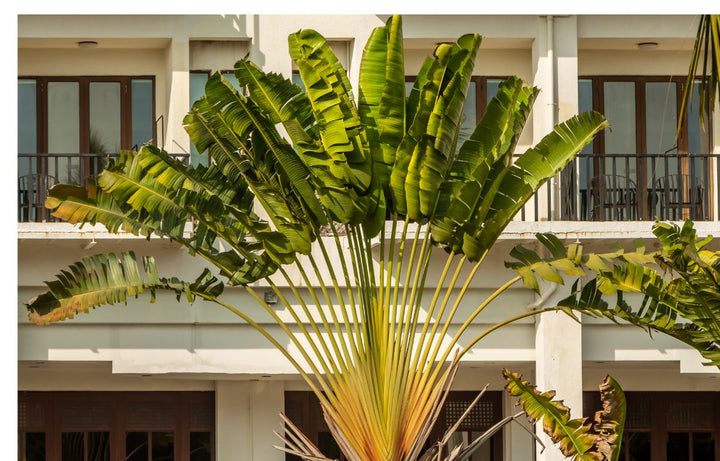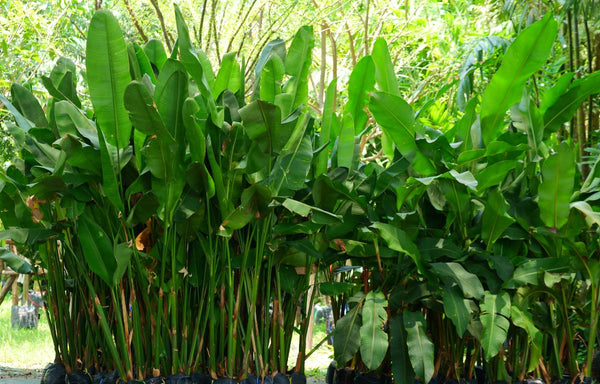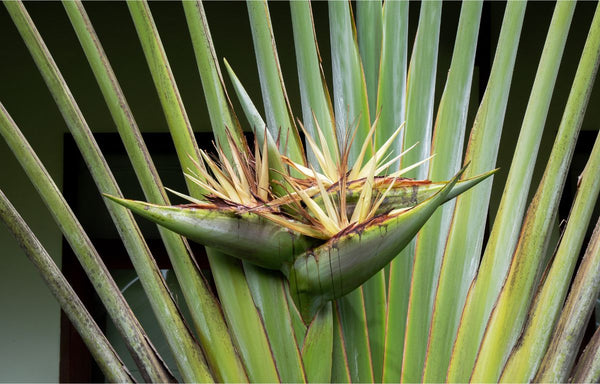
Plant Profile: Traveller's Palm, Ravenala madagascariensis
Plant Profile: Traveller's Palm, Ravenala madagascariensis
Found native to the island of Madagascar, the Traveller's Palm or Ravenala madagascariensis is not actually a true palm tree but is in fact a member of a very small genus called Strelitziaceae, commonly known for its cousin Strelitzia or Bird of Paradise.

When young, the Traveller's Palm is often mistaken for the Bird of Paradise or Strelitzia. Although the Bird of Paradise's paddle-shaped leaves appear very similar, the plant grows in a clump formation whereas the Traveller's Palm's foliage grows outwards from a central stem as seen in palm trees. The stems of the Traveller's Palm are also much thicker and longer than its cousin, with larger, more oval-shaped leaves.
The plant's name is thought to have originated from colonial travellers to Madagascar who would sometimes drink the rainforest water collected at the base of the plant's leaves, hence, Traveller's Palm. Another theory believes that the plant would grow its leaves in an east to west direction following the path of the sun. Not only this but the upright leaves are thought to have resembled a compass needle guiding travellers around the island.
Traveller's Palms are late bloomers and can only flower once they reach a mature age of ten years or even older. The flowers are cream or white in colour and are enclosed in green boat-shaped bracts giving them the iconic Strelitziaceae bird-shaped flower head. The flowers grow from the axils where the leaves and stems diverge and contain vibrant blue-coloured seeds that are a favourite food of the Madagascar Lemurs who eat and distribute them around the forest.
Caring for a Traveller's Palm
-
Light: These plants prefer bright, indirect light. Place them near a window where they can receive constant filtered sunlight or outdoors where they can receive partial shade and sunlight. Due to the Traveller's Palm's large leaves, it can withstand direct sunlight for short periods.
- Water: Water can be cupped and stored at the base of the leaves to be released during dry conditions. However, the plant will thrive best with a regularly maintained watering routine to keep the soil moist but not soggy. Ensure proper drainage to prevent root rot.
- Temperature and Humidity: Predominantly found growing in the tropical and subtropical regions of Madagascar, the Traveller's Palm will thrive in warm and humid environments. Having said this, they can grow well with consistent temperatures between 18°C - 29°C with adequate humidity levels of around 40%. Most indoor spaces have a humidity range somewhere around 30-40%.
- Soil: Use well-draining premium potting soil or a home mixture of peat moss, perlite, and sand. This helps prevent waterlogging and promotes healthy root growth. The Traveller's Palm can also be planted directly into most types of garden soil, including sandy and clay composite soil. However, it is important to fertilise the soil before planting.
- Fertiliser: Feed the plant with a balanced, water-soluble fertiliser during the growing season. Follow the instructions on the fertiliser packaging for the correct dosage. Plants that are young to middle-aged usually require fertilising every 2-3 months or so. However, older plants require much less nutrients as growth naturally slows and requires less energy. Keeping in mind that in the wild, Traveller's Palms have an average lifespan of around seven to ten decades.
- Pruning: Remove any dead or damaged leaves to maintain the plant's appearance. Trim back any brown or yellowed fronds at the base to keep its fan-like appearance. New shoots will only grow from the central trunk.

Problems and Solutions
While Travellers Palm Plants are generally hardy, they can face a few common issues.
- Pot Bound: Traveller's Palms develop thick roots that are incredibly strong and hardy. Enclosed garden beds or pots must provide adequate room for the roots to grow and spread out as the plant matures. This plant must be repotted if pot-bound and can crack or even break through pots that are too small.
- Brown Tips: Brown tips on the leaves can indicate underwatering or low humidity. Increase watering and mist the leaves regularly to improve humidity.
- Yellow Leaves: Yellow leaves may indicate overwatering or nutrient deficiency. Adjust your watering schedule and consider fertilising the plant more frequently.
- Pest Infestation: Common pests that can affect Travellers Palm Plants include spider mites and mealybugs. Use an organic insecticidal soap or spray like neem oil to eliminate the pests. Remember to flush out the cupped base of the leaves to eliminate pests or bugs that may be hiding in there.
- Root Rot: Overwatering or poor drainage can lead to root rot. Ensure the plant is not sitting in water and adjust your watering habits accordingly.
- Frost: Traveller's Palms are tolerant to cold temperatures for short periods of time. However, they are very frost-sensitive, so avoid planting them outdoors in areas that can drop down to single digits or subzero temperatures in winter.
- Propagation: Propagation is difficult for Traveller's Palms and can't be stem propagated or air layered. New plants can only be grown from seeds collected from the flowers and planted.
Traveller's Palms are not as commonly found in Australia as the Bird of Paradise. However, they are readily available to purchase from specialised tropical plant nurseries. Although they thrive in tropical and humid environments, they also do well in moderate conditions. With its large open-faced leaves, the Traveller's Palm will make a stunning feature of any plant collection indoors and outdoors.
For more impressive large-leaf plants, read our Plant Profile: Elephant's Ear.
